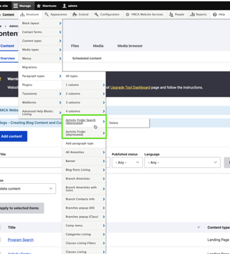Deprecating and removing components
Occasionally, old code is deprecated from the YMCA Website Services codebase. To minimize disruption to existing sites, we use the following process:
- Decide: Before removing components from the distribution, we gather feedback from the community to protect active projects from having components accidentally removed. We accomplish this via messaging in the YMCA Website Services Slack channel and discussion on monthly calls.
- Deprecate: Once a decision is made, we notify users that the feature will be removed soon. The deprecated component is moved from the
YMCA Website Servicespackage group to theYMCA Website Services (Deprecated)package group. For example, see Deprecate Daxko Program Registration Paragraph. Deprecation notices are posted in point and quarterly releases of YMCA Website Services. - Uninstall: Before removing code, components should be uninstalled via an update hook in the distribution, and any hard dependencies should be removed. Uninstalls must occur at least one point (fix) release after the deprecation notice.
- Remove: Complete removal of the component from the codebase or
composer.jsonshould happen at least one quarterly (feature) release after the deprecation notice.
Additionally, the following housekeeping steps should be taken when deprecating a component:
- Add the release where the deprecated component has been uninstalled to the important versions document in the Wiki.
- Decouple the code to external GitHub repositories with all history of commits, marked as
openy-decoupled, and archive the repository.
UX/CX for deprecated components
To deliver a high-quality upgrade path and keep the distribution on the leading edge of technologies, we occasionally replace old and aged components with new ones for a better User Experience (UX) and Content Experience (CX).
To achieve deprecations, we have a policy that aims to provide a comfortable migration path for all components of the distribution.
When we create a component that will replace an old one, we must introduce a period of overlap when both components are available in the system for some time (typically 6-18 months). This allows users time and resources to migrate from the old component to the new one before it is removed from the distribution. See the Activity Finder v3 to v4 migration.
Deprecated components are moved to the deprecated modules group in the list of modules at Admin > Extend. Also, we add
lifecycleandlifecycle_linkto the documentation in every deprecated module to provide enough information for the community. See Deprecate openy_gxp.info.yml.All titles of deprecated components in the Content Editing interface should be renamed to add the suffix
(deprecated)to help Content Managers daily avoid choosing an old component and using a new one.For most content components, an automated migration path is expensive and sometimes impossible. Therefore, we have a “lazy migration” practice in our community, which puts the responsibility of migration on Content Managers and Strategists. Once new components are available in the distribution, all editors should start using them and rebuild old pages by replacing old components with new ones. After the communicated timeframe (6-18 months), old components are removed from the distribution. However, if an association needs it, the component will be available as an independent—but unsupported—project. A 3rd-party agency or developer can support it as long as needed.
After the communicated timeframe (6-18 months), the Core team will remove the component from the distribution and keep it in an independent project for archival reasons. Usually, the project is marked as archived/obsolete to clarify that it is not supported and is possibly insecure.
If the normal timeframe (6-18 months) is not achievable due to unforeseeable circumstances, the Core team will add proper notifications and tutorials for the community to help migrate comfortably in a shorter time. See the GroupEx Pro API deprecation notice.
